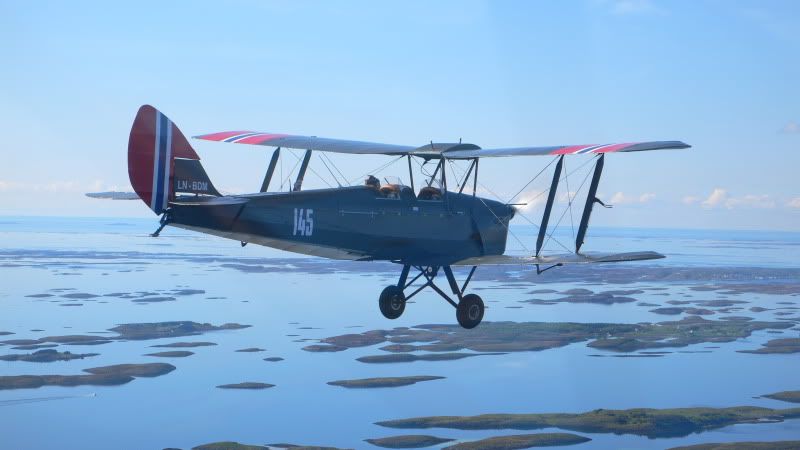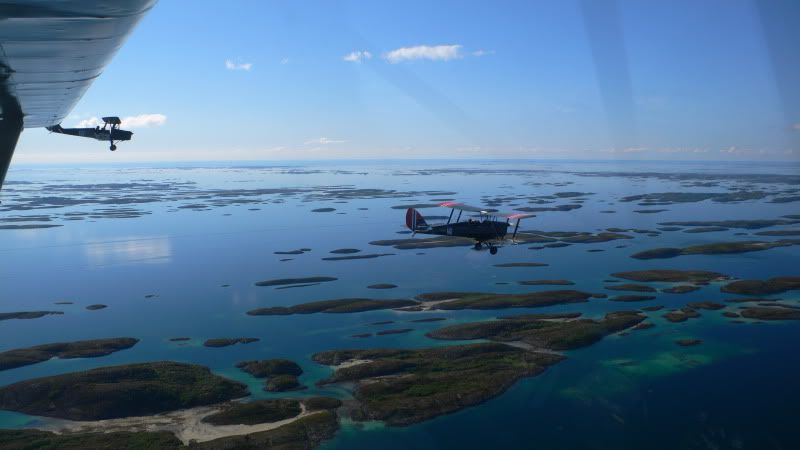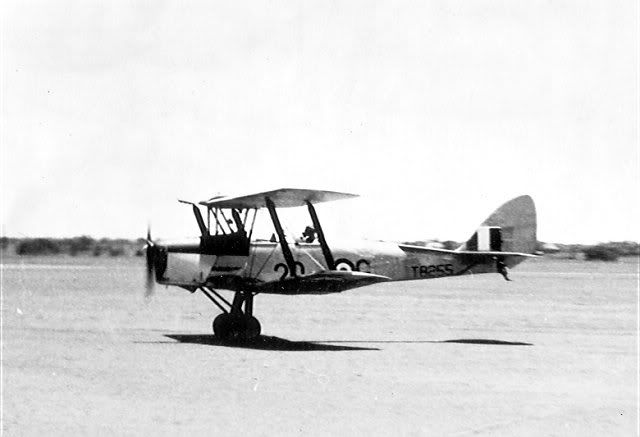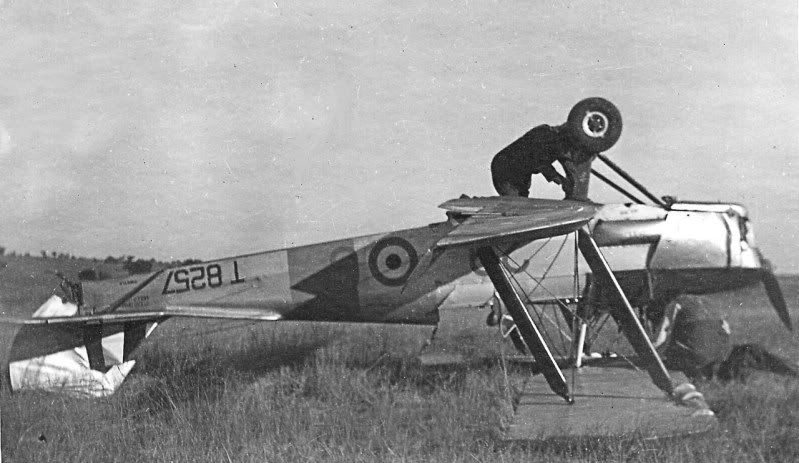Tiger Moth
Join Date: Nov 2006
Location: Somewhere in England
Posts: 105
Likes: 0
Received 0 Likes
on
0 Posts
It might be Fantome's picture at post#17 that's done it. Usually a Moderator is close by and requests that the picture be re-sized by the poster. Nice picture anyway!
Join Date: Aug 2007
Location: Utterly insignificant little blue-green planet, unregarded yellow sun, unfashionable end, western spiral arm, Milky Way
Age: 38
Posts: 276
Received 0 Likes
on
0 Posts
Love the Tiger Moth. Not because it is comfortable or easy to fly; It is neither! But it teaches you to aviate, rather than just fly.. There are no two better aeroplanes to learn on than the Tiger Moth and the Cub. It has done more to develop my flying skills than anything else I have done in my flying career so far. Highlights include flying it to And°ya in the Lofoten islands in Norway, at 70 degrees north, and becoming proficient enough to be able to land the thing in 10 to 12kt crosswinds on grass. Ours have no brakes and no tailwheels. This way you also learn that taildraggers aren't finished flying until they're tied down or parked in the hangar.




Gnome de PPRuNe
Join Date: Jan 2002
Location: Too close to Croydon for comfort
Age: 60
Posts: 12,635
Received 300 Likes
on
168 Posts
Nice, think it was LN-BDM I saw in the Tiger Club hangar at Redhill back in the 1970s...
Join Date: Aug 2007
Location: Utterly insignificant little blue-green planet, unregarded yellow sun, unfashionable end, western spiral arm, Milky Way
Age: 38
Posts: 276
Received 0 Likes
on
0 Posts
That might very well be. It's ex-RAF DE248, then it became G-ANSC before coming here as LN-BDM. deHavilland serial # 85294.
Gnome de PPRuNe
Join Date: Jan 2002
Location: Too close to Croydon for comfort
Age: 60
Posts: 12,635
Received 300 Likes
on
168 Posts
Semmerm, she moved to Norway in '54 so presumably was either visiting the TC for social reasons, or perhaps in with Rollasons for some work. Either way, nice to see her!
Join Date: Jul 2013
Location: UK
Age: 68
Posts: 736
Likes: 0
Received 0 Likes
on
0 Posts
There seems to be a range of opinions about the Tiger Moth!
Slight thread drift to broaden the discussion, hope no-one minds....
To me it seems self-evident that any light, piston-engined, open cockpit, tail-dragging bi-plane of that era is bound to be found lacking in many ways, especially to us more accustomed to modern aircraft.
I would be interested to know which planes of similar design, purpose and age are considered to be significantly better or worse, and the reasons for this.
Slight thread drift to broaden the discussion, hope no-one minds....
To me it seems self-evident that any light, piston-engined, open cockpit, tail-dragging bi-plane of that era is bound to be found lacking in many ways, especially to us more accustomed to modern aircraft.
I would be interested to know which planes of similar design, purpose and age are considered to be significantly better or worse, and the reasons for this.
Pretty subjective in the analysing ..... even the differences between a Tiger and a Chippy are so marked, comparisons, as they say, are invidious. Bit like a
First World War test pilot being asked to say in what way a Maurice Farman Shorthorn differed from an Avro 504K . (He'd splutter in his beer). Or a Model T Ford from an Escort or a Capri. Or an apple from a pear. Chalk and cheese.
Go back into Flight and Flight International archives. Dig out flight reports by Cliff Barnett, Hugh Field, Mark Lambert and a number of other outstanding pilot/journalists. When comparisons are made, they are valid , apposite, and between closely matched competitive models, then in production.
First World War test pilot being asked to say in what way a Maurice Farman Shorthorn differed from an Avro 504K . (He'd splutter in his beer). Or a Model T Ford from an Escort or a Capri. Or an apple from a pear. Chalk and cheese.
Go back into Flight and Flight International archives. Dig out flight reports by Cliff Barnett, Hugh Field, Mark Lambert and a number of other outstanding pilot/journalists. When comparisons are made, they are valid , apposite, and between closely matched competitive models, then in production.
Join Date: Apr 2008
Location: nowhere
Posts: 1
Likes: 0
Received 0 Likes
on
0 Posts
From a pilots point of view, you are flying a huge aircraft compared to the Tiger Moth. Everything is larger from cockpit size to height above the ground. From an operational point of view, this means more hangar space will be used.
If one goes by the theory that more coordination inputs are an advantage to teaching a new student flying skills, then the Tiger Moth wins in that area as a lack of rudder input for initiating a turn will send the ball to the far limits of its tube. For an experienced pilot, the Stearman inflight handling is much more pleasant and responsive.
A fleet of Stearmans will burn significantly more fuel than Tiger Moth's. So if cost or fuel shortages enter the picture during a war, the Stearman can be at a disadvantage.
A handcrank for the stearman back in the old days seems much safer than handpropping on a slippery grass field for a Tiger Moth.
I think ground visibility is better in the Tiger Moth with its narrow engine allowing you to stick your head out the side of the aircraft for a better view.
Ground handling in the Stearman is more responsive with its brake system using toe brakes compared to Tiger Moths with no brakes installed. It is much less of an issue on grass where the Tiger Moth did most of its flying of course but a grass surface can become quite hard in the dry summer and the Tiger Moths with tailwheels are really affected by the wind in that case. On pavement, the Tiger Moths with brakes obviously are better but taxiing in a significant wind is more complicated as hands are needed for throttle, control stick and hand brake. Stearman is much easier with its toe brakes.
While I read stories of people flying Tiger moths in quite strong winds, I would rather be in a Stearman if the wind picks up, especially on a hard surface as most Tiger moths have no brakes. Even for those that do have brakes(handbrake on left side), I think the Stearman wins out. So the training might end sooner on a windy day at the airbase with tiger Moths,
Avoiding low speed situations is so critical with these high drag aircraft and so many have stalled over the years. My feeling is that the Tiger moth is more vulnerable to its draggy airframe than the Stearman. Even in a normal climb, you have to watch that Tiger Moth airspeed carefully. After an engine failure, depending on phase of flight, I think more immediate action is required to avoid a stall in the Tiger Moth.
I would say the Stearman airframe is much more rugged.
Last edited by JammedStab; 4th Feb 2014 at 13:15.
Join Date: Oct 1999
Location: UK
Posts: 3,325
Likes: 0
Received 0 Likes
on
0 Posts
I found the Stearman to be a bit of a bus. Big, heavy, honest, but not really all that nice to fly (but better than a Tiger). I once flew a Waco biplane in Florida and found it very similar to the Stearman.
The aeroplane that the Tiger Moth should have been is the Stampe. They look similar, but the Tiger has truly awful handling and un-harmonised controls. The Stampe is a delight. Not as much of a delight as the Chipmunk, but then, what is?
The aeroplane that the Tiger Moth should have been is the Stampe. They look similar, but the Tiger has truly awful handling and un-harmonised controls. The Stampe is a delight. Not as much of a delight as the Chipmunk, but then, what is?

JammedStab,
I was going to write about the Stearman, but you beat me to it.
I agree with almost everything you said. However, I think if a WWII student pilot had never flown anything else, he probably wouldn't have noticed the size.
As SSD says the Stearman is nicer to fly than a Tiger. Those are the only two biplanes I've flown. I'll have to get my hands on a Stampe one day (and a Pitts!)
I was going to write about the Stearman, but you beat me to it.
I agree with almost everything you said. However, I think if a WWII student pilot had never flown anything else, he probably wouldn't have noticed the size.
As SSD says the Stearman is nicer to fly than a Tiger. Those are the only two biplanes I've flown. I'll have to get my hands on a Stampe one day (and a Pitts!)
I learned to fly in a Tiger Moth and all approaches to land were glide. In other words you simply closed the throttles on base leg at a position where you judged you could glide at 58 knots and land in the first third of the field.
If you came in too high you fixed that by side slipping. If you looked like undershooting you simply applied sufficient throttle power to level out momentarily then closed it and resumed the glide. The glide approach was not only the normal technique for landing but gave the pilot constant experience on how wind affected the glide and its application for real forced landings without power.
I don't know about UK or Canada but glide approaches as taught in Australian flying schools in light singles (Cessnas and Warriors for example) are quite different to the original techniques used in Tiger Moths and I don't know why..
Nowadays you have to tell ATC if you intend to do a glide as it becomes a "non-normal" landing even though the Cessna POH states you can land it power off or power on for the same speeds. In fact there are flying schools that do not permit students to practice glide approaches for landing. They are seen as too hard without an instructor to supervise the landing! The technique taught in Australian flying schools requires the instructor to close the throttle late downwind as if it is an engine failure and the student has to get in from there.
The problem is spacing between other aircraft in the circuit as you have to cut someone else off in order to get quickly on to base to get in. This is because it is treated like a forced landing. That is why in Australia there is official advice you have to advise ATC so that other aircraft in the circuit with give you wide berth to do your own thing. How pathetic is that..
Whoopy-do - everyone stay clear 'cos I am about to do a glide approach in my Cessna 150.
Bloody silly, really when you think that for literally hundreds of thousands of Tiger Moths flights before, during and after WW2, glide approaches were considered normal approach and landing procedure. Now they are called "non-normal" landings requiring ATC notification
If you came in too high you fixed that by side slipping. If you looked like undershooting you simply applied sufficient throttle power to level out momentarily then closed it and resumed the glide. The glide approach was not only the normal technique for landing but gave the pilot constant experience on how wind affected the glide and its application for real forced landings without power.
I don't know about UK or Canada but glide approaches as taught in Australian flying schools in light singles (Cessnas and Warriors for example) are quite different to the original techniques used in Tiger Moths and I don't know why..
Nowadays you have to tell ATC if you intend to do a glide as it becomes a "non-normal" landing even though the Cessna POH states you can land it power off or power on for the same speeds. In fact there are flying schools that do not permit students to practice glide approaches for landing. They are seen as too hard without an instructor to supervise the landing! The technique taught in Australian flying schools requires the instructor to close the throttle late downwind as if it is an engine failure and the student has to get in from there.
The problem is spacing between other aircraft in the circuit as you have to cut someone else off in order to get quickly on to base to get in. This is because it is treated like a forced landing. That is why in Australia there is official advice you have to advise ATC so that other aircraft in the circuit with give you wide berth to do your own thing. How pathetic is that..
Whoopy-do - everyone stay clear 'cos I am about to do a glide approach in my Cessna 150.
Bloody silly, really when you think that for literally hundreds of thousands of Tiger Moths flights before, during and after WW2, glide approaches were considered normal approach and landing procedure. Now they are called "non-normal" landings requiring ATC notification

It has done more to develop my flying skills than anything else I have done in my flying career so far
Join Date: Nov 2004
Location: Asia's Fine City
Posts: 462
Likes: 0
Received 0 Likes
on
0 Posts
Here's a nice and emotive PIREP for the Tiger Moth.
The last paragraph is nice and some's it up for me as I get older.
de Havilland Tigermoth Pilot Report
In the right hands it's capable of this and it's not too shabby at all.
Tiger Moth biplane aerobatics - YouTube
Having flown Tiger Moths and considerably hours more in various Pitts S2's there are certainly differences. LOL. Both are wonderful in their own but very different ways. Enjoy them all.
The last paragraph is nice and some's it up for me as I get older.
de Havilland Tigermoth Pilot Report
In the right hands it's capable of this and it's not too shabby at all.
Tiger Moth biplane aerobatics - YouTube
Having flown Tiger Moths and considerably hours more in various Pitts S2's there are certainly differences. LOL. Both are wonderful in their own but very different ways. Enjoy them all.
Gnome de PPRuNe
Join Date: Jan 2002
Location: Too close to Croydon for comfort
Age: 60
Posts: 12,635
Received 300 Likes
on
168 Posts
FP, Brian Lecomber wrote a comparison of the Tiger, Stampe and Jungmann for Flyer several years ago. Being a gentleman with sensitive aerobatic hands he naturally had a great preference for the handling of the Stampe and the Jungmann!
If money were no object, I'd have one of each (and a Chippy)...
I'm not a pilot and I haven't yet flown in any of the three, but I have a feeling that I'd enjoy the challenge of learning to fly the Tiger well.
If money were no object, I'd have one of each (and a Chippy)...
I'm not a pilot and I haven't yet flown in any of the three, but I have a feeling that I'd enjoy the challenge of learning to fly the Tiger well.
Join Date: Jul 2013
Location: UK
Age: 68
Posts: 736
Likes: 0
Received 0 Likes
on
0 Posts
Many thanks all for your interesting comments and links. I feel that the Stampe and Bucker are great comparisons and sound rather superior to the Tiger Moth. The Stearman is certainly interesting to read about but to my mind is a class up in size, weight and power; noise too!
I certainly enjoyed the "elemental" feel of the Tiger Moth, wafting its way sedately through the breezes.
I certainly enjoyed the "elemental" feel of the Tiger Moth, wafting its way sedately through the breezes.






